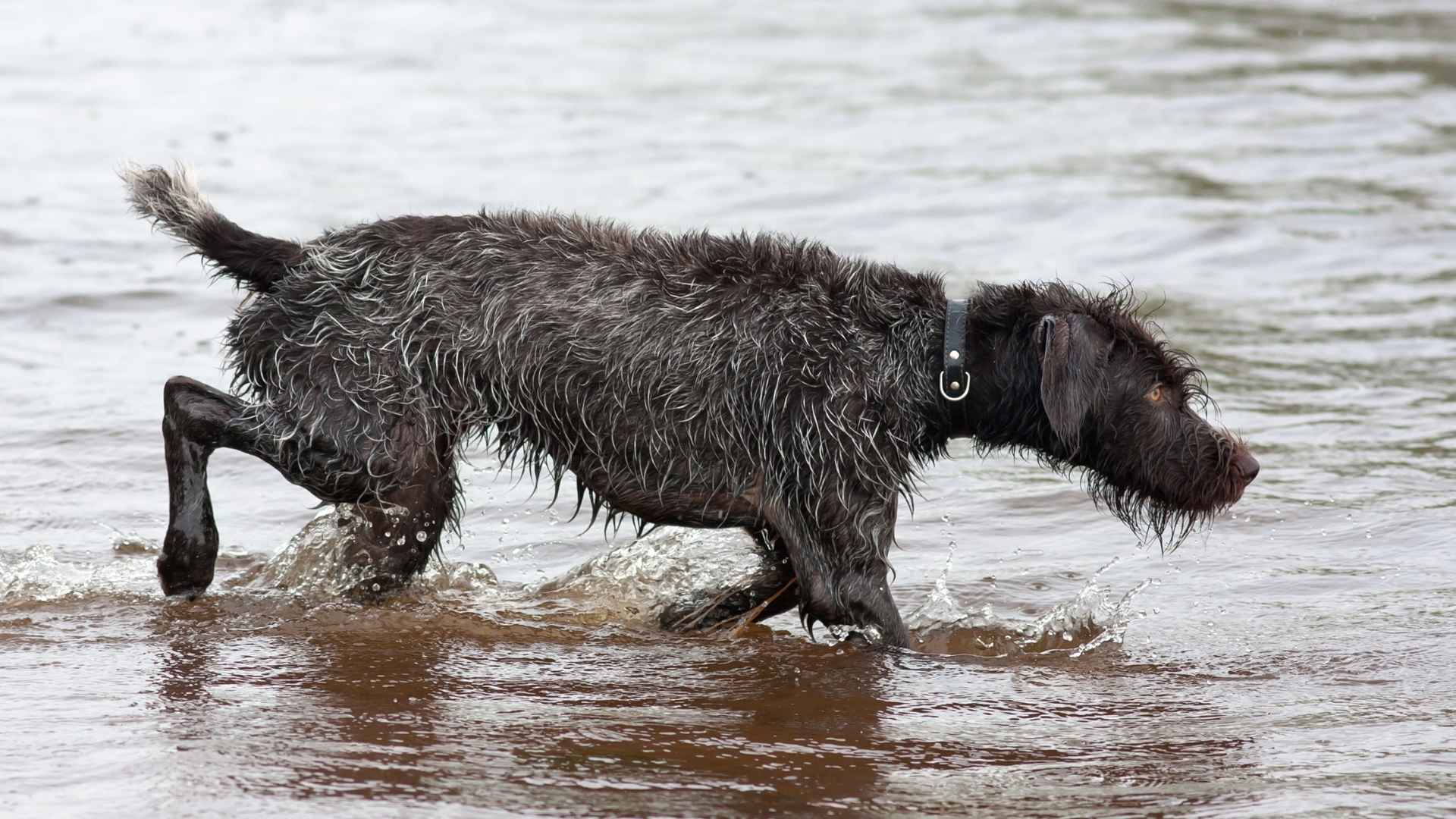There’s nothing quite like the thrill of a crisp morning by the water’s edge, waiting for ducks or geese to take flight. But any seasoned waterfowl hunter will tell you—the real magic often comes on four legs. A skilled hunting dog isn’t just a companion; it’s the partner that makes the hunt possible.
From braving icy waters to tracking down downed birds in dense marsh grass, the right breed brings endurance, intelligence, and an unmatched enthusiasm for the chase. But not every dog is cut out for the job. Some are natural-born swimmers, others are tireless retrievers, and a few have been bred for generations to thrive in water and wet, rugged environments.
In this article, we’ll explore the seven best dog breeds for hunting waterfowl, highlighting what makes each one special and why hunters around the world swear by their loyalty and performance in the field.
Best Dog Breeds for Hunting Waterfowl
1. Golden Retriever
Golden Retrievers are one of the most recognizable and beloved dog breeds, known for their affectionate personalities and versatile skills. Originally bred as sporting dogs, their strong build, deep chest, and water-repellent coat make them well-suited for retrieving in both land and water.
Their intelligence and eagerness to please also explain why they excel as therapy dogs, service animals, and loyal companions at home.
Golden Retriever’s thick double coat can range from pale cream to deep red. This coat is water-resistant, a trait that highlights their roots as sporting dogs. However, it also means they shed heavily throughout the year, so consistent brushing and grooming are key to keeping their fur healthy and manageable.
PetMD states that Goldens thrive in social environments and get along well with children, strangers, and other pets. Their playful yet gentle demeanor makes them a favorite for families who want a dog that balances energy with affection. They often nudge their owners to keep petting them, showing just how much they love attention.
Golden Retrievers are prone to certain health conditions, which prospective owners should consider. Common concerns include hip and elbow dysplasia, hypothyroidism, atopic dermatitis, and inherited eye diseases. They also face higher risks of cancers such as lymphoma and hemangiosarcoma.
Goldens remain one of the most popular breeds in the United States for good reason. Their combination of loyalty, trainability, and joy in activities like swimming, hunting, and playing fetch continues to win over countless families.
For those who can provide daily exercise, regular grooming, and preventive care, a Golden Retriever offers years of companionship and love.
Quick Tips
Brush at least twice a week to manage heavy shedding and prevent matting.
Schedule yearly vet checkups to monitor for breed-specific health risks like hip dysplasia and thyroid issues.
2. Labrador Retriever
The Labrador Retriever is among the most versatile and recognizable breeds in the world. Bred from the St. John’s water dog in Newfoundland and later refined in the United Kingdom, Labs were originally prized for retrieving fish and waterfowl.
Their endurance, strength, and natural swimming ability remain hallmarks of the breed today. Over the years, they have expanded beyond the field to become beloved family companions and reliable service dogs.
One of the defining traits of the Labrador Retriever is its friendly and outgoing nature. They typically get along with children and other pets, making them an excellent choice for households that value social, affectionate dogs. Without sufficient exercise, however, Labs can grow restless and destructive, which is why they thrive in active homes.
Labradors excel at more than companionship. They are commonly trained as therapy dogs, search-and-rescue workers, and even in law enforcement roles such as narcotics and explosives detection.
Their intelligence and eagerness to please make training highly rewarding, especially when approached with consistency and positive reinforcement. With early socialization, they mature into calm, confident, and well-mannered adults.
Caring for a Labrador is straightforward, but their dense double coat sheds heavily, especially during seasonal changes. Weekly brushing reduces loose fur and distributes oils for coat health. Labs also require frequent exercise—two hours a day is often recommended—and they delight in swimming and retrieving games. Grooming routines should also include regular nail trimming, ear cleaning, and dental care.
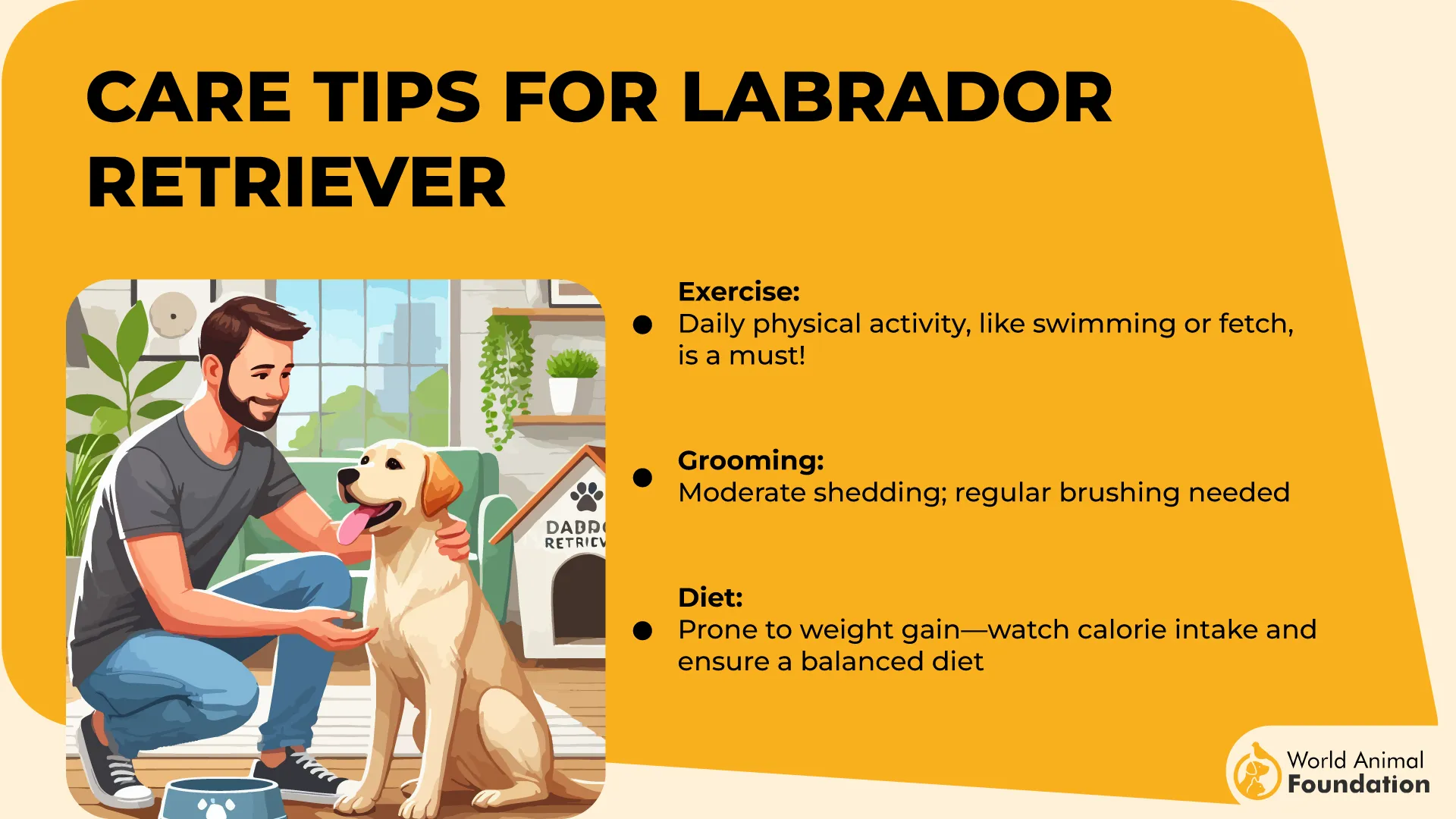
While generally healthy, Labradors are predisposed to certain conditions, such as hip and elbow dysplasia, tricuspid valve disease, progressive retinal atrophy, and bloat. They are also prone to obesity, in part due to their love of food. Portion control, proper diet, and routine veterinary care are essential to keeping them fit and extending their 10–12 year lifespan.
Quick Tips
Provide at least two hours of daily exercise, including swimming or retrieving games.
Monitor food portions closely to prevent obesity, a common issue in this breed.
3. Boykin Spaniel
The Boykin Spaniel was developed in South Carolina in the early 1900s to hunt wild turkeys and waterfowl. Compact enough for small boats yet strong enough to retrieve, it quickly became a favorite of hunters along the Wateree River. The breed’s origins trace back to a stray named “Dumpy,” refined by Whit Boykin into the dog we know today.
This medium-sized spaniel has a deep liver coat that’s wavy to curly, with lighter feathering at times. The color served as natural camouflage during hunts, allowing the dog to blend into swampy terrain. Weekly brushing and occasional trimming keep the coat in good condition, while floppy ears require regular cleaning.
Boykins are affectionate, outgoing dogs that enjoy being part of the family. They get along well with children and other pets if socialized early. Trainability is a strong trait, as they thrive when given tasks such as retrieving, obedience, or field work.
According to Hill’s Pet, daily exercise is essential for this high-energy breed. At least 40 minutes of activity keeps them balanced, whether it’s swimming, running, or a long game of fetch. Without consistent outlets, their boundless energy may turn into restlessness.
The Boykin adapts well to both field and home life. It’s a lively, hard-working hunting partner outdoors, and a cheerful, affectionate pet indoors. This versatility makes it especially popular with families who enjoy an active, outdoorsy lifestyle.
Quick Tips
Give them daily exercise with structured activities like swimming or retrieving.
Brush weekly and check ears often to prevent matting and infections.
4. American Water Spaniel
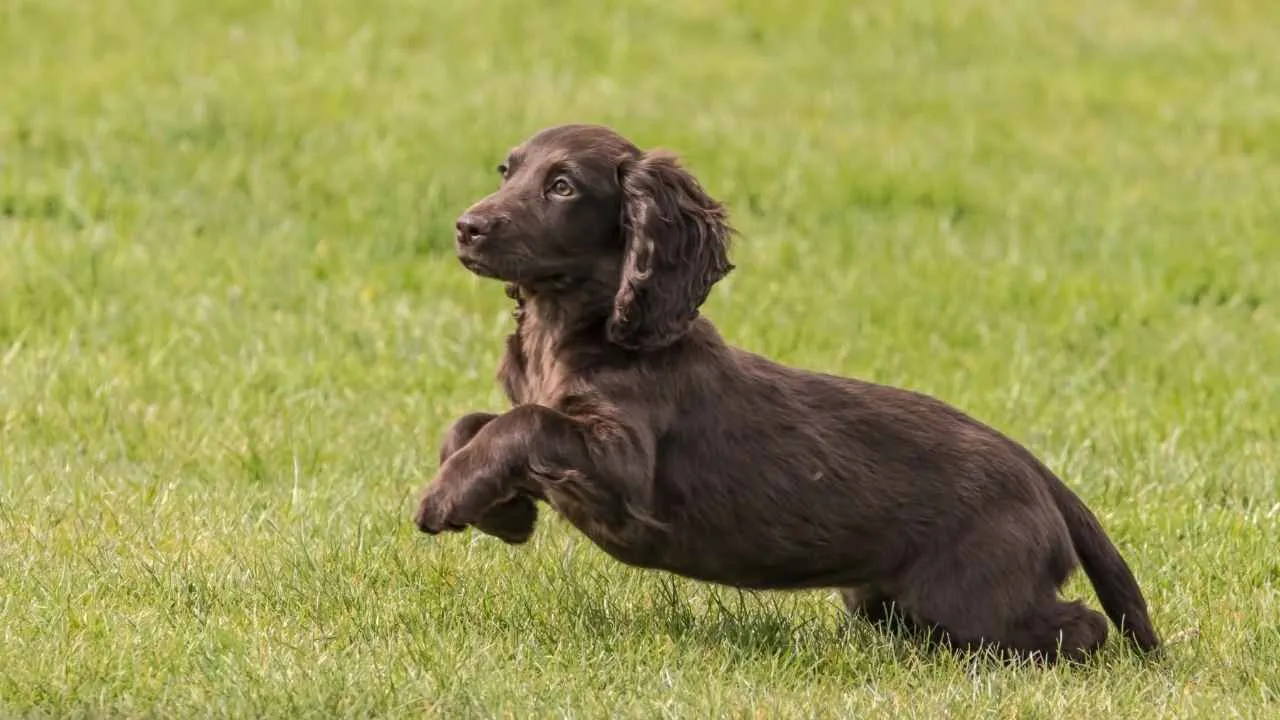
The American Water Spaniel is a rare U.S.-bred sporting dog, known for its muscular build, curly coat, and natural skill in the water. Developed in the Great Lakes region, this breed was designed to retrieve in icy rivers while also handling small game on land.
Its dense, water-repellent coat and webbed toes make it well-suited for swimming and working in cold environments.
Cheerful and eager to join family activities, the American Water Spaniel bonds closely with its people. While affectionate at home, it can be somewhat reserved with strangers, so early socialization helps build confidence. With consistent training, it learns quickly and responds well to positive reinforcement methods.
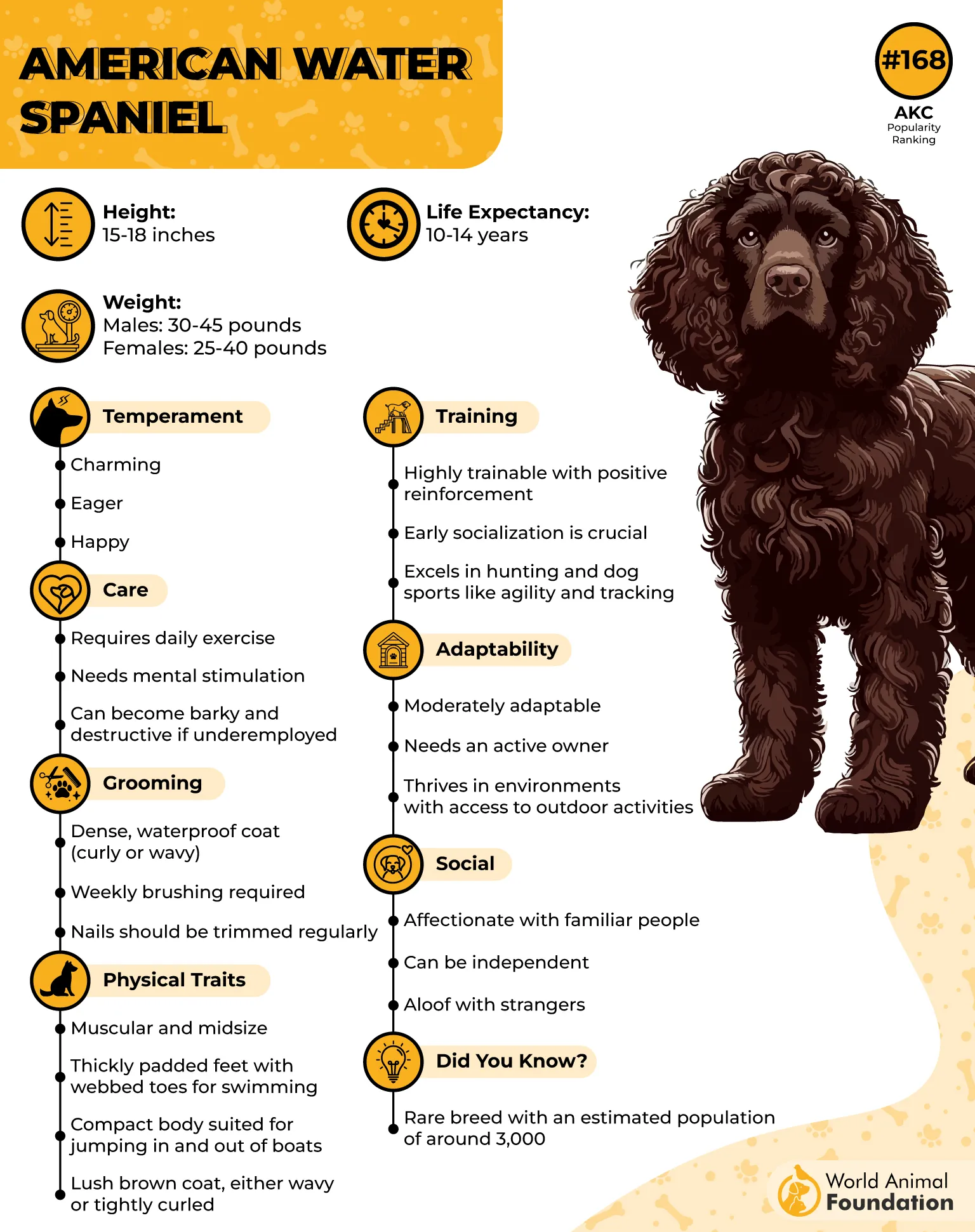
Exercise is important for this medium-energy dog. About an hour of daily activity—whether jogging, swimming, or fetch—keeps it happy and balanced. Dog sports like dock diving or agility also provide both physical and mental challenges. Without this, boredom may lead to barking or destructive behavior.
Grooming needs are moderate. Weekly brushing removes loose fur and keeps the coat’s natural curl in good condition. Shedding is minimal compared to many sporting breeds, though it increases seasonally. Bathing once a month, regular nail trimming, and careful ear cleaning after swims help maintain overall health.
Health concerns to watch for include hip dysplasia, cataracts, retinal dysplasia, and heart conditions. Degenerative myelopathy can also appear in some lines, affecting mobility over time. Regular vet visits and preventive care are key to supporting this spaniel’s 10–14-year lifespan.
Quick Tips
Plan at least one hour of daily exercise, ideally with swimming or retrieving.
Brush weekly and dry ears after water activities to reduce infection risks.
5. Nova Scotia Duck Tolling Retriever

The Nova Scotia Duck Tolling Retriever, or “Toller,” is a medium-sized gundog with a thick, water-repellent double coat. Its striking coloring ranges from light orange to deep red, often with white markings on the chest, feet, or tail tip. With webbed feet and a waving plume of a tail, the breed is built for working in and around water.
Tollers were developed in Nova Scotia to perform a unique hunting role: luring ducks closer with their tail movements before retrieving them for hunters.
This unusual skill gave them their name, linking “tolling” with their retrieving ability. Their agility and enthusiasm in both roles made them a standout among duck hunting dogs.
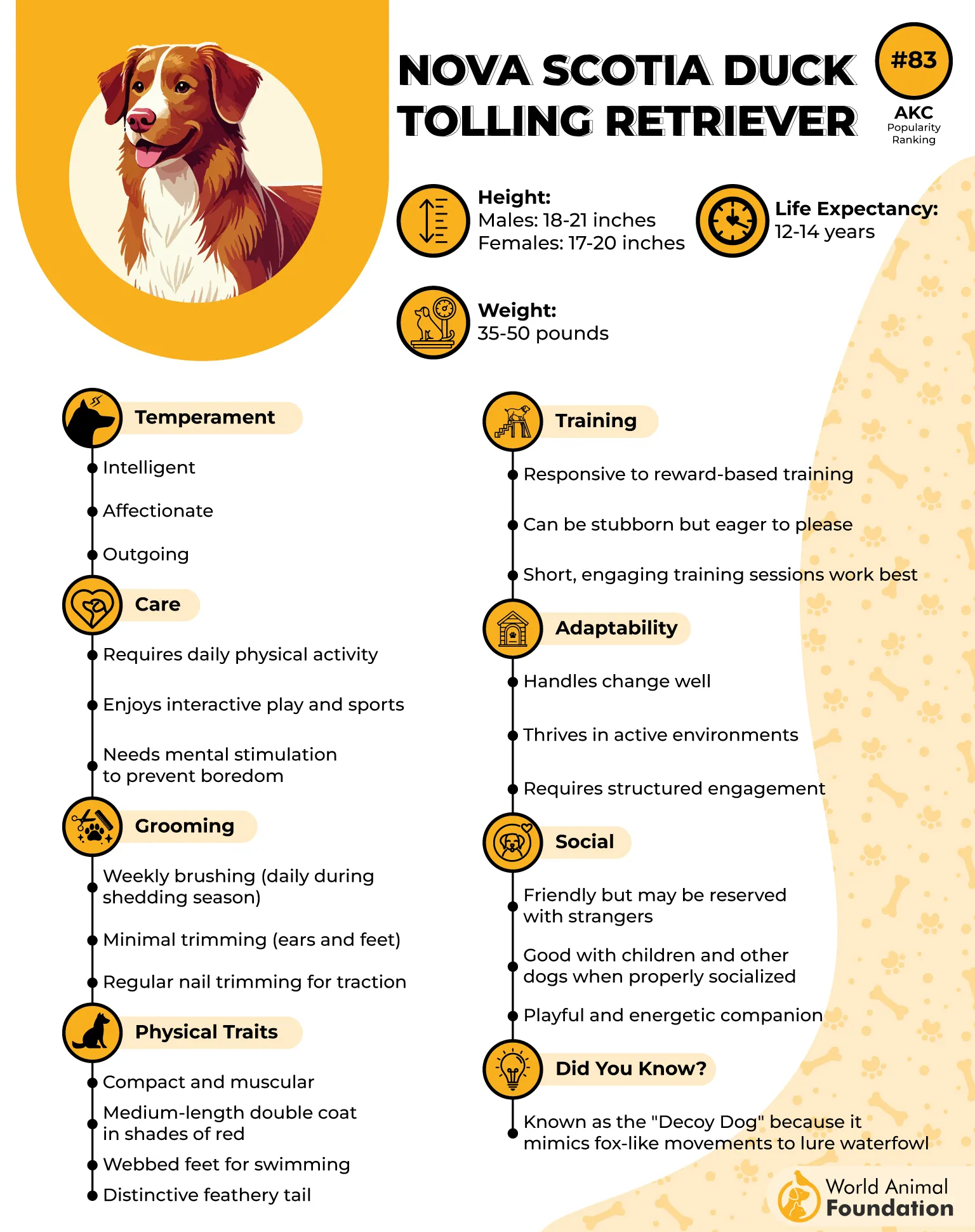
These retrievers are highly energetic and need plenty of outdoor activity. Long daily walks, play sessions, or participation in sports like agility and flyball help keep them happy. They are best suited for active families with access to large spaces or the countryside.
As per Purina, they are curious, intelligent, and affectionate with family, though they may be reserved around unfamiliar dogs. Early training and socialization ensure they remain confident, cooperative companions.
Grooming requires regular effort, as their feathered coat should be brushed every other day to stay in good condition. Shedding is moderate, and ears should be checked after swimming. With good care, the Toller lives 10–14 years, thriving as both a hard worker and lively family pet.
Quick Tips
Engage their natural instincts with retrieving games and outdoor sports.
Brush every other day and keep ears dry after water sessions.
6. Chesapeake Bay Retriever
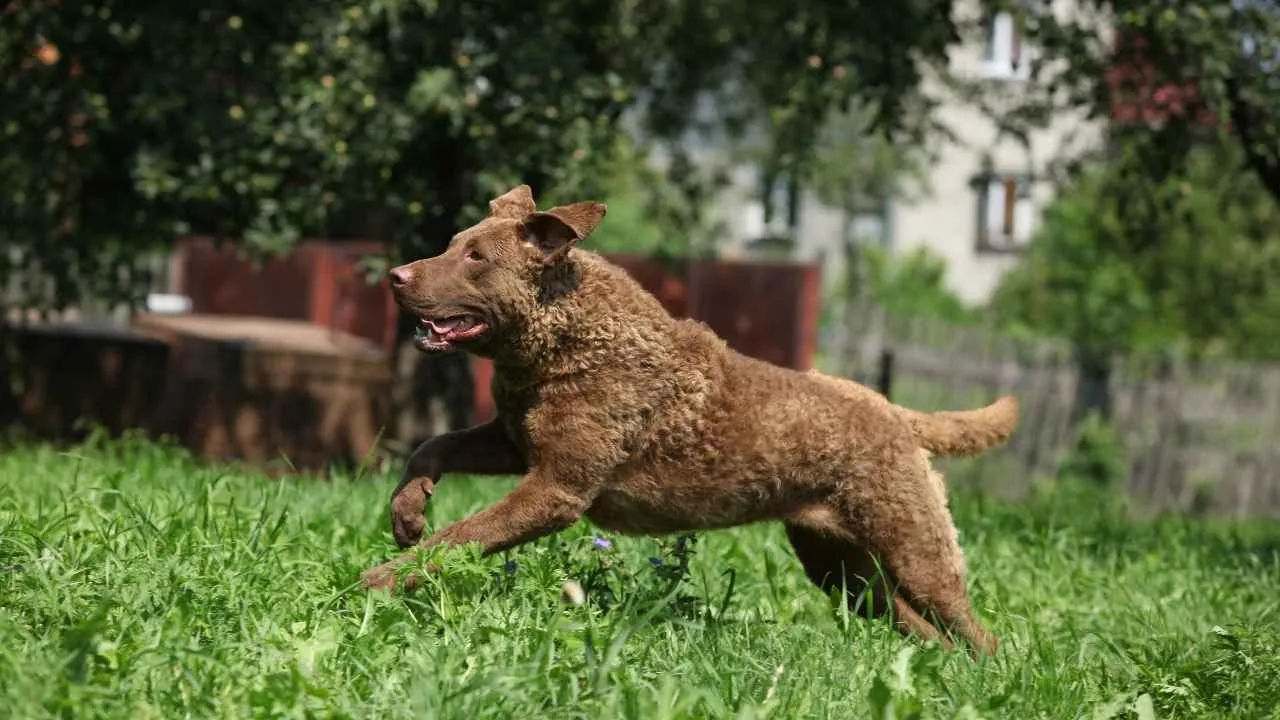
The Chesapeake Bay Retriever was bred along the Maryland coast in the early 1800s for one purpose: retrieving waterfowl in freezing, rough conditions.
Its dense, oily double coat provides insulation against icy winds and cold surf, making it one of the toughest hunting companions. With a muscular build, deep chest, and striking yellow-amber eyes, the Chessie is as rugged as it is recognizable.
This breed is known for stamina and independence. They are powerful swimmers, willing to plunge into harsh waters to retrieve ducks for hours at a time. Beyond their work ethic, Chessies are intelligent and affectionate with their families, though they tend to be more protective and watchful compared to other retrievers.
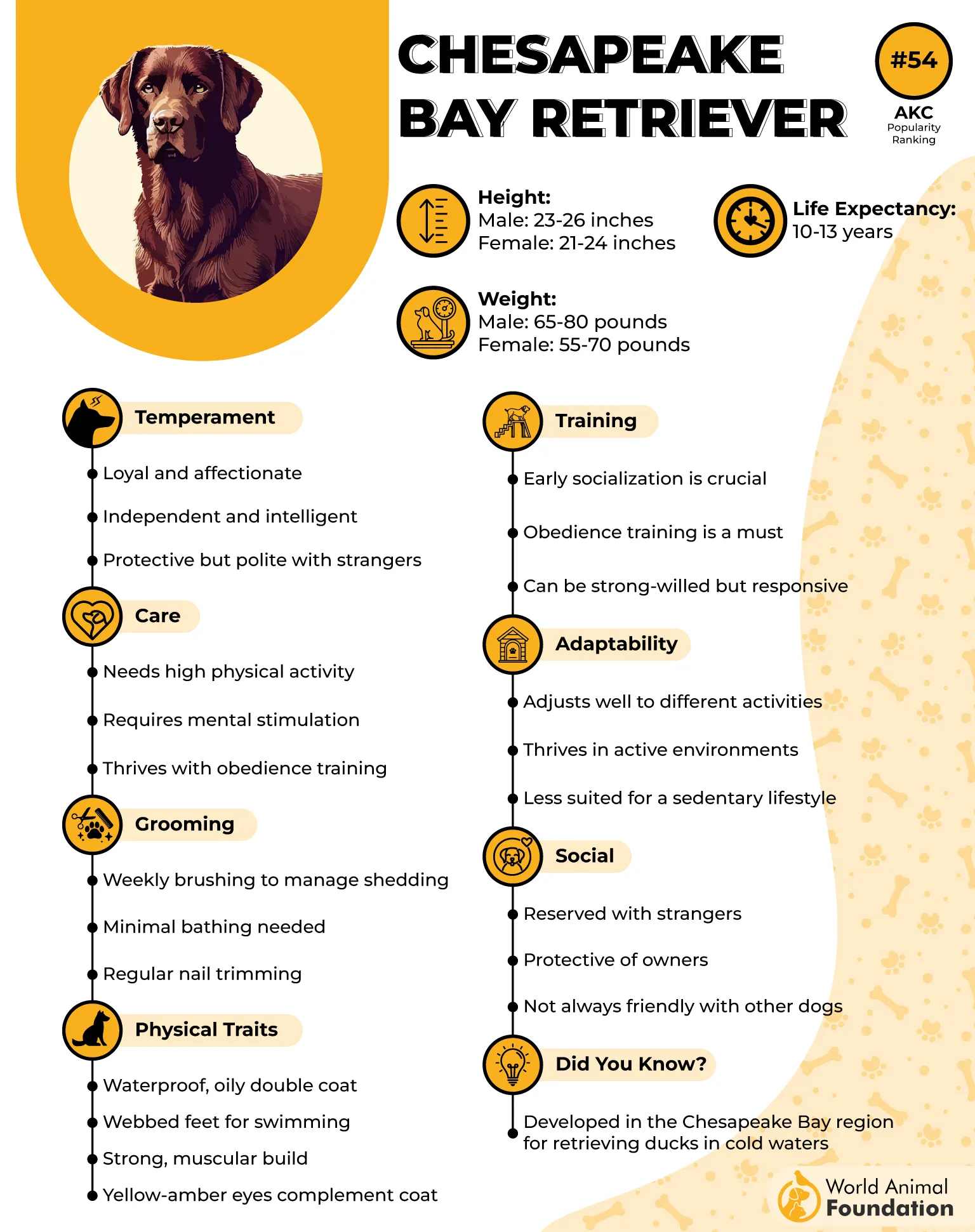
Exercise is vital for these athletic dogs. They thrive on long hikes, swims, and runs, and they love field activities that challenge both body and mind. Without sufficient outlets, their high energy can lead to frustration, so they are best suited to active homes with outdoor space.
Caring for their coat is relatively simple. Weekly brushing helps manage shedding and distribute the natural oils that keep the coat water-resistant. Regular nail trimming, ear checks, and dental care round out the routine. Because they are hardy dogs, minimal grooming effort still yields a healthy and well-kept retriever.
While generally healthy, Chesapeake Bay Retrievers are prone to certain conditions like hip dysplasia, progressive retinal atrophy, and degenerative myelopathy.
Responsible breeders screen for these issues, but owners should stay vigilant with routine vet visits. With proper care, Chessies typically live 10–13 years, serving as both reliable working dogs and excellent companions at home.
Quick Tips
Give them daily vigorous exercise, ideally including swimming or retrieving.
Brush weekly to maintain their protective double coat and reduce shedding.
7. Flat-Coated Retriever
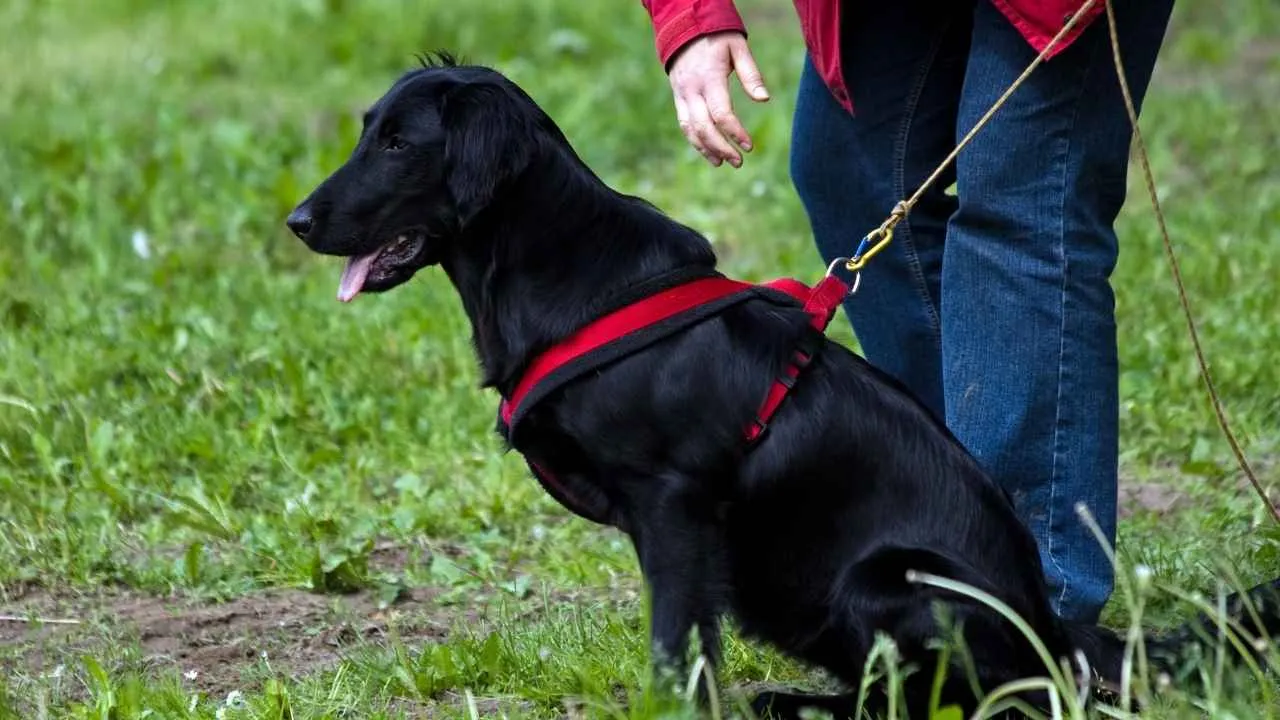
The Flat-Coated Retriever is a medium-sized sporting dog from England, bred in the mid-1800s. Closely related to the curly-coated retriever and other early gundogs, it was designed for retrieving waterfowl and upland game.
With its glossy black or liver coat, athletic build, and lively personality, the Flat-Coat stands out as a cheerful, hardworking hunting partner.
This retriever is best known for its perpetual puppy-like outlook. Owners often describe them as joyful, eager, and full of energy. They get along well with children and other animals, making them a reliable family companion in addition to a field dog. Because of their social nature, they don’t like long hours alone and may develop separation anxiety.
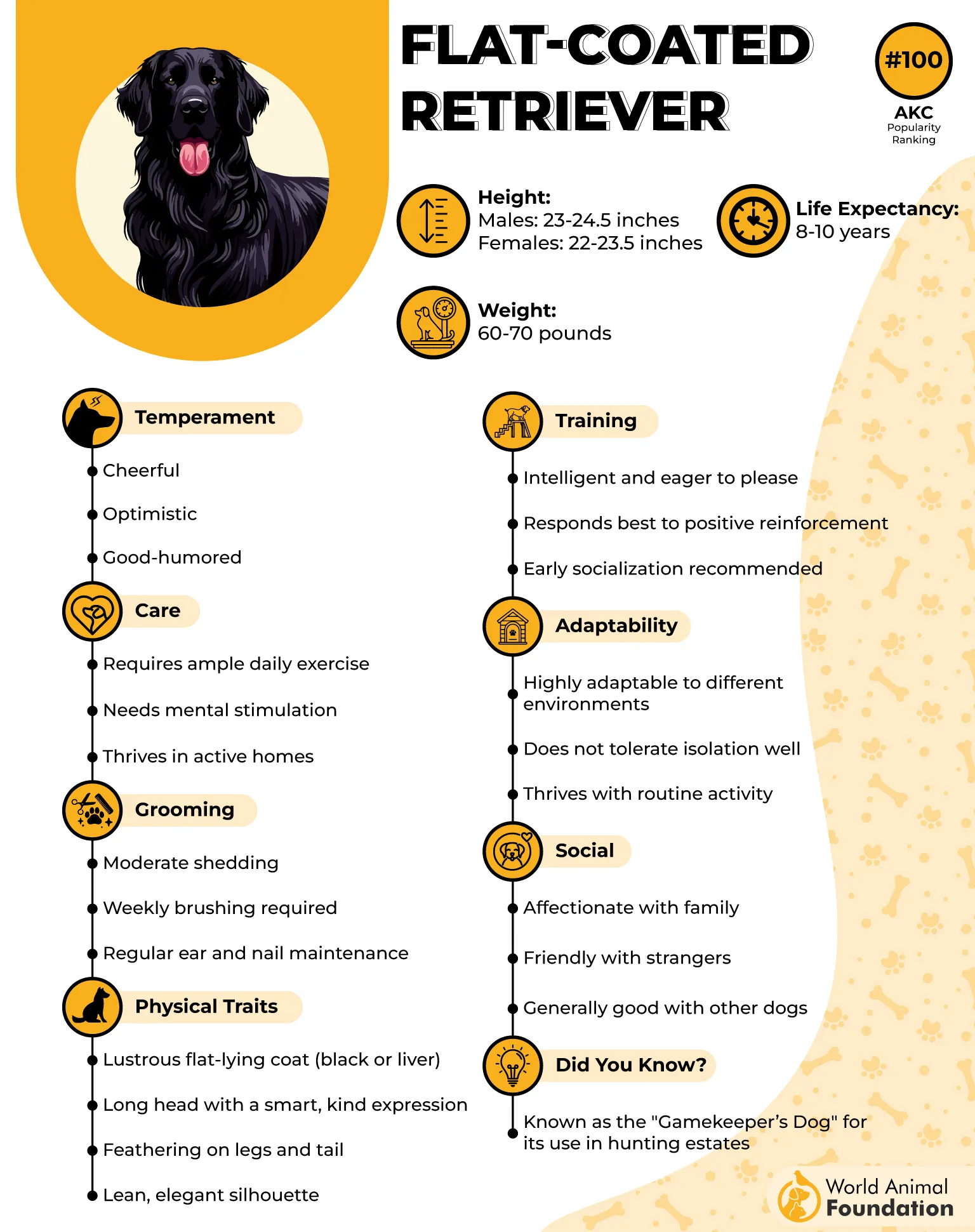
Exercise is a top priority for the Flat-Coat. Expect to dedicate at least two hours each day to vigorous activity such as running, hiking, swimming, or playing fetch. Dog sports like agility or rally also provide the mental stimulation they need. Without it, they may turn to barking or chewing.
Grooming is moderate and fairly simple. Weekly brushing helps manage seasonal shedding and keeps their medium-length coat free of tangles. Regular checks for ear infections, nail trims, and monthly baths keep them in good condition, especially after time outdoors.
Health-wise, the Flat-Coat can face concerns such as hip dysplasia, glaucoma, and certain cancers. With a typical lifespan of 8–10 years, routine vet care and a balanced diet are important for keeping them strong.
Their stamina, eagerness to please, and natural ability in the field make them one of the greatest dogs for active families who love the outdoors.
Quick Tips
Provide at least two hours of exercise daily with both physical and mental challenges.
Brush weekly and check ears after swimming to prevent infection.
Conclusion
Choosing the right retriever is about more than tradition; it’s about matching lifestyle, terrain, and hunting style with the dog’s natural strengths. Recognized by the American Kennel Club, these breeds remain essential partners for hunters who value skill, loyalty, and endurance. Whether you call them a duck dog, a bird dog, or simply a trusted companion, each excels in its own way. Some specialize in hunting ducks, others shine with upland bird hunting, and many prove themselves among the best duck hunting dogs thanks to their adaptability.
A versatile hunting dog must handle both waterfowl and upland birds, thriving in marshes, forests, and fields alike. Such versatile dogs are prized by upland bird hunters for their balance of drive and cooperation. From pointing upland birds to retrieving downed birds in cold water, their instincts define what makes a versatile breed.
Whether it’s the Irish Water Spaniel—a proud state dog—or other breeds like the small retriever or liver roan types with short coats, hunters value their excellent noses, strong desire, and resilience in harsh conditions. With proper training, obedience training, and field experience through hunt tests, these popular dogs become great family pets, great companions, excellent retrievers, and truly great dogs—energetic dogs that work well with other dogs and serve as excellent companions for life.


